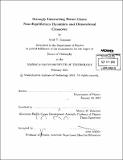| dc.contributor.advisor | Martin W. Zwierlein. | en_US |
| dc.contributor.author | Sommer, Ariel T. (Ariel Tjodolv) | en_US |
| dc.contributor.other | Massachusetts Institute of Technology. Department of Physics. | en_US |
| dc.date.accessioned | 2014-01-09T19:58:38Z | |
| dc.date.available | 2014-01-09T19:58:38Z | |
| dc.date.issued | 2013 | en_US |
| dc.identifier.uri | http://hdl.handle.net/1721.1/83820 | |
| dc.description | Thesis (Ph. D.)--Massachusetts Institute of Technology, Dept. of Physics, 2013. | en_US |
| dc.description | Cataloged from PDF version of thesis. | en_US |
| dc.description | Includes bibliographical references (pages 163-176). | en_US |
| dc.description.abstract | Experiments using ultracold atomic gases address fundamental problems in many-body physics. This thesis describes experiments on strongly-interacting gases of fermionic atoms, with a focus on non-equilibrium physics and dimensionality. One of the fundamental dissipative processes in two-component gases is the transport of spin due to relative motion between the two spin components. We generate spin transport in strongly-interacting Fermi gases using a spin dipole excitation and measure the transport coefficients describing spin drag and spin diffusion. For resonant interactions, we observe strong suppression of spin transport, with the spin transport coefficients reaching quantum-mechanical limits. Dimensionality plays an important role in the formation of bound states between pairs of particles. We tune the dimensionality of a Fermi gas from three to two dimensions (2D) using an optical lattice potential and observe the evolution of the pair binding energy using radio-frequency spectroscopy. The binding energy increases as the lattice depth increases, approaching the 2D limit. Gases with resonant interactions, which have no two-body bound state in three dimensions, show a large binding energy determined by the confinement energy of the lattice wells. The themes of non-equilibrium dynamics and dimensionality come together in the study of soliton excitations in superfluid Fermi gases. We create a planar defect in the superfluid order parameter of an elongated Fermi gas using detuned laser light. This defect moves through the gas as a solitary wave, or soliton, without dispersing. We measure the oscillation period of the soliton and find it to exceed the predictions of mean-field theory by an order of magnitude. | en_US |
| dc.description.statementofresponsibility | by Ariel T. Sommer. | en_US |
| dc.format.extent | 176 pages | en_US |
| dc.language.iso | eng | en_US |
| dc.publisher | Massachusetts Institute of Technology | en_US |
| dc.rights | M.I.T. theses are protected by
copyright. They may be viewed from this source for any purpose, but
reproduction or distribution in any format is prohibited without written
permission. See provided URL for inquiries about permission. | en_US |
| dc.rights.uri | http://dspace.mit.edu/handle/1721.1/7582 | en_US |
| dc.subject | Physics. | en_US |
| dc.title | Strongly interacting Fermi gases : non-equilibrium dynamics and dimensional crossover | en_US |
| dc.type | Thesis | en_US |
| dc.description.degree | Ph.D. | en_US |
| dc.contributor.department | Massachusetts Institute of Technology. Department of Physics | |
| dc.identifier.oclc | 865574507 | en_US |
